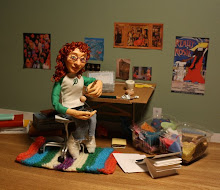Writing and drawing are both forms of
art, arts used for communication and storytelling. If we look back,
writing evolved from drawing, from pictographs indicating the hunt,
crops, or the phases of the moon. We still use writing and images
together- signs, picture books, posters, graphic novels, webpages.
Indeed, much of the information you consume is a marriage of words
and images. So why has writing engulfed drawing in the classroom?
I ask this question after working with
twenty-three K-3 students in a summer visual arts program. (I specify
visual arts as the state of music and theatre education is another
essay entirely.) I talked with students about reading images, and
they identified speech bubbles, thought bubbles, and motion lines. We
drew characters and looked at David Wiesner's Tuesday, a
picture book told using panels and spreads, and in which the only
text is the time. Together, we read a few sequences, focusing on how
the pictures were telling a story. Then, using pencils and paper, the
students set to work on their own sequential pieces.
There were some creative stories of
dragons, fish, princesses, and soccer players. Some students chose to
use speech bubbles and thought bubbles while others used captions
(which they placed in boxes despite the fact that we had not
discussed captions). Three third-grade girls drew only a single
image after being asked; the entirety of their stories were written.
Of the twenty-three students in the class, only two didn't use any
text, both kindergarteners who are still learning to write.
Despite examples, including circle,
blob, and scribble characters, these third grade girls in at least
their third day (if not second week) of a visual arts summer camp,
told me that they were scared to draw because they couldn't, or
because it wouldn't be good enough. I'm used to confronting this fear
in students grades 7 and up (adults being the most fearful) but in
students entering the third grade? Why was this happening?
Part of this could be attributed to
the fact that these were three female students. Much has been written
on the socialization of girls. Judgement of their drawings by their
peers could be frightening enough to stop them from drawing. However,
not all three of these girls were sitting together, and they were all
able to draw their characters during the character development
period. It was only when asked to tell a story that they reverted to
writing.
Writing versus drawing and literacy
versus visual literacy are discussions I often have with parents and
teachers in the bookstore. Picture books, these adults tell me, are
for preschool and kindergarteners, their children need to read. To
which I respond that yes, children need to learn to read, but they
also need to develop visual literacy skills, the skills that enable
them to read images. Just as writing goes hand in hand with reading,
so too does drawing pair with visual literacy.
I know the teachers of these students
are teaching them writing and reading (and some students did seriously awesome work). Teachers may even be teaching some
visual literacy when they read picture books. But drawing is reserved
for their once-every-6-day art class. Even in elementary school,
drawing is seen as superfluous, something some kids are good at, not
something to be encouraged in every child throughout elementary
school as a form of communication. Just as we encourage a love of
reading and writing, should we not encourage a love of seeing and
drawing? How can our students understand the significance of Lascaux,
hieroglyphics, cuneiform, and illuminated manuscripts if they don't
know how to look and draw?
From history, we know that writing
grew from drawing. So, too, do a child's skills. Scribbles are
pictures and words. While they eventually distinguish themselves,
they are tied together. Let them exist side by side. Just as we
strive to encourage multiple literacies, let's nurture multiple forms
of communication. Let drawing and writing exist side by side in the
classroom. You'll probably find it only increases the possibilities
of communication.
To end on a positive note, here's a table of awesome drawings!










